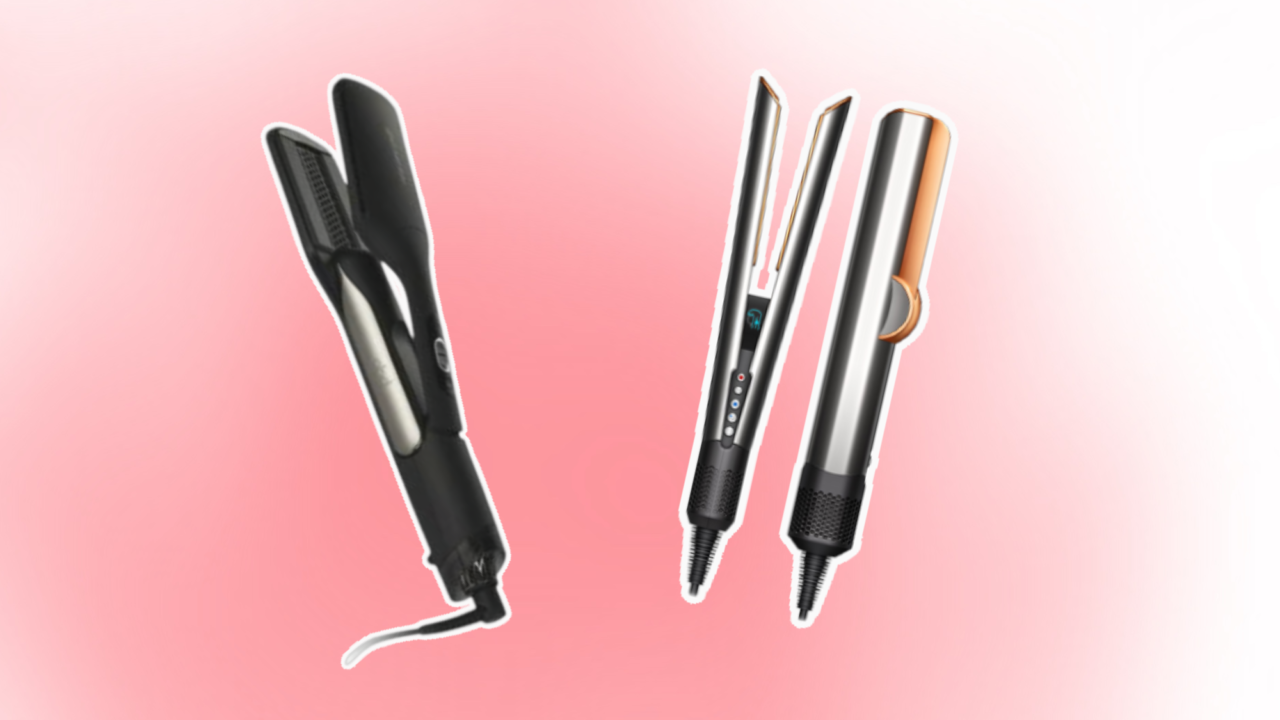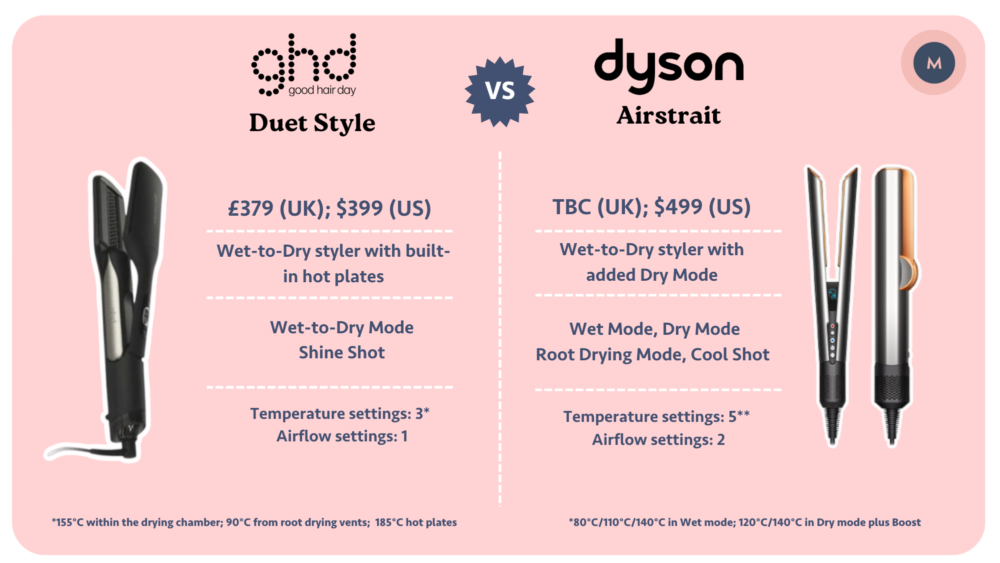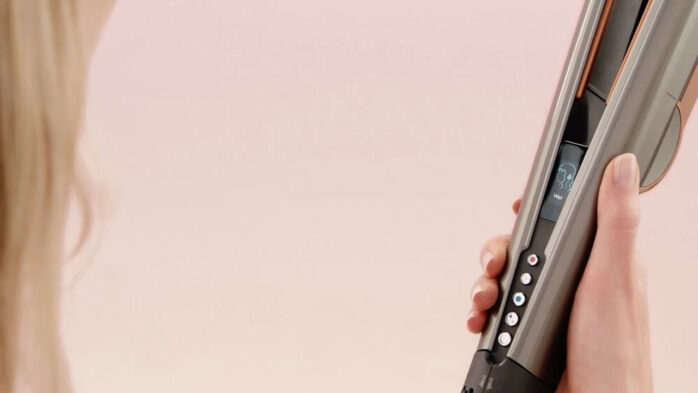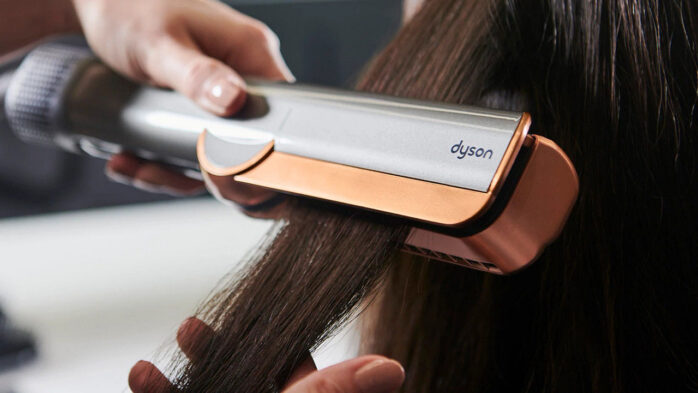
In our GHD Duet Style vs Dyson Strait head-to-head, we look at the different features, design, and early performance of the two stylers to see which wet-to-dry straightener is potentially worth your time and money
JUMP TO SECTION
Click the links below to jump to the relevant section:
GHD Duet Style vs Dyson AirStrait: Similarities
GHD Duet Style vs Dyson AirStrait: Differences
GHD Duet Style vs Dyson AirStrait: First impressions
GHD made headlines earlier this year when it launched the first-of-its-kind wet-to-dry straightener called the GHD Duet Style.
It promised to revolutionise styling, with experts describing it as having the potential to “rock the industry” thanks to “game-changing innovation.”
This is because it combined hair drying features and straightening plates in a single styler.
There have, of course, been stylers in the past that style as they dry but until now these have predominantly been hot brushes (something we’re huge fans of and can’t recommend the Revlon One-Step Volumizer Plus highly enough!)
The reason why we’re so enamoured of such stylers is that they save time and often create styles we can’t manage ourselves with a regular hair dryer and/or straightener.
Our interest was well and truly piqued when GHD launched its Duet Style, and we’re now just as excited following the launch of the Dyson Airstrait – a wet-to-dry straightener from the iconic engineering brand.
You can read more about what we think of the new Airstrait in our hands-on Dyson Airstrait review, and read more about the new GHD hair straightener in our GHD Duet Style review.
And below we explain the key differences between the two products and our early impressions in our GHD Duet Style vs Dyson Airstrait guide.
 mamabella | mamabella
mamabella | mamabella Below we list the similarities between the two products, followed by their key differences, and then our early opinion of each. We have spent time testing both products but not as long as we’d usually like so please take that into consideration.
Once we’ve had the chance to fully review both, we’ll update this page. It’s important to us that the information we give is as informed as possible and while our early impressions are useful, and can certainly give you a sense of how they both work, the impact on our hair health and so on needs to be verified.
 GHD
GHD Both brands describe their respective tools as wet-to-dry stylers. Both resemble straighteners, albeit with much larger and thicker designs; both have hot air vents along the inside of the respective styler’s arms; and both have features designed to dry the roots and add shine.
Both brands claim their respective stylers create minimal heat damage.
When used to dry the hair, they’re used in an almost identical way. Sections of wet hair are clamped in between the two chambers and as the stylers are passed over the hair, they remove moisture from the hair.
Dyson hasn’t specified how many times you should, or shouldn’t pass the Airstrait over your hair, whereas GHD advises against passing your hair through the chambers more than four times.
GHD’s CTO, Dr Rob Milner told mamabella that this is because “three passes are sufficient to dry and style the hair so, in our testing, we used four passes to ensure the hair was fully dried. We didn’t see a user need to dry further, so we chose four passes for our standard tests.”
 Dyson
Dyson The Dyson Strait offers two main styling modes – Wet and Dry – and only relies on hot air to style your hair.
There are five temperature settings to choose from across the two modes. You can select these via the buttons on the control panel.
Wet mode:
Dry mode:
In addition, the Airstrait has a separate Root Drying mode that directs a concentrated flow of air from the side of the styler that is used to dry the roots. It then has a Cool Shot mode, used to finish your style.
The GHD Duet Style offers a Wet mode, in which hot air removes the moisture from the hair. Once the hair is dry – and only when it’s dry – you can switch to Shine Shot mode. This turns off the hot air and turns on two hot plates which work in the same way as the plates on previous GHD straighteners, such as the GHD Platinum Plus, to straighten the hair.
In Wet mode, the air flowing through the drying chamber doesn’t exceed 155°C (285°F), and the air from the roots vents maxes out at 90°C (195°F). These two vents run simultaneously so you can dry the roots and the hair at the same time.
 GHD
GHD In Shine Shot mode the plates reach 185°C (365°F). This is the standard temperature seen across GHD’s wider hair straightener range and is what the brand describes as the “optimal” temperature to mould the hair while causing minimal damage.
The GHD Duet Style costs £379 in the UK and $399 in the US. The Dyson Airstrait costs $499 in the US and the UK prices are yet to be announced. If previous Dyson prices are anything to by, we’d expect the Airstrait to cost in the region of £399. This is because the Corrale, as one example, costs $499.99/£399.99. However, we’ll confirm this when we know more.
On one hand, we love the variety that comes from the Airstrait’s range of features. We can use the styler in a number of ways and we imagine it could effectively replace our hair dryer/hot brush with ease. The Dry mode takes this versatility to the next level and genuinely (in our opinion) offers something unique in the market that appeals directly to how we like to style our hair.
As we explain in our hands-on Airstrait review, there have already been a number of occasions where we wished we had the Airstrait and could have really benefited from its use.
The downside is that there is a lot going on with the Airstrait and, while the controls are intuitive, have the potential to feel a little overwhelming. Which mode are you in? Which temperature setting do you need for your hair type? When do you need to use the root drying mode? Is it time for the cool shot?
The GHD Duet Style removes a lot of this mental load. It selects the air temperature for you, and combines the root drying function with the main dryer so it has all bases covered. In our experience, this root drying feature can be a little hit and miss though, and only dries from beneath the root. It’s not possible to dry from above. This is great for adding volume, but less so for creating a sleek finish or removing frizz.
 Dyson
Dyson This is a minor point, however, because having the Shine Shot option effectively turns the Duet Style into a GHD straightener. The hot plates remove any frizz and create a smooth finish that even the best cool shot would struggle to match.
WHAT TO BE AWARE OF
To change your style, hydrogen bonds within each hair strand have to be broken before being reset into their new shape. This is done via heat or moisture.
It’s why straighteners can bend and mould the hair, and why your hair becomes flat and more flexible when it’s wet.
When hair is wet, water naturally weakens these bonds. In this state, the bonds are more elastic and can be reset as hair dries but it also means that your hair is at its most fragile.
If you apply too much heat, it causes these bonds to break and damages the health of your hair, as well as your ability to restyle it.
Both the GHD Duet Style and Dyson Airstrait claim to strike the right balance between maximising hair styling while minimising hair damage, but we highly recommend that you still use a heat protectant.
Also, avoid passing the stylers over your hair too many times as this increases the potential heat, and thus the potential damage.
Considering how long it’s been drummed into us that using excessive heat on wet hair is the worst thing you can do, both wet-to-dry straighteners make us a little nervous (given how close the hot air gets to the hair) however, the GHD Duet Style’s use of hot plates exacerbates this a little.
In reality, it’s no different from drying your hair normally before running separate straighteners over it. Yet the fact the two are combined could make it tempting to skip the drying step and on the occasions we’ve used the Duet Style, we’ve almost gone overboard with heat protectant and making sure the hair is super dry before switching to the plates.
You can read more in our GHD Duet Style review.
Dr. Milner confirmed to us that the heaters on the plates in the Duet Style are the latest evolution of GHD’s ceramic technology meaning “the closest product in the market [to the GHD Duet Style] is the Platinum Plus.”
This includes a ceramic heater element inside each of the heater plates and an external non-stick, heat-resistant ceramic coating. As a result they’re designed to maintain a steady stream of heat.
In this way, with the Duet Style, you’re getting the equivalent of two GHD products in one thus making the price a little easier to swallow.
On the topic of price, there’s no denying that both stylers are expensive and, while for the price you’re getting the very best, market-leading technology in each, it does limit their respective appeal.
If the UK prices for the Dyson Airstrait end up following suit with the rest of its range, it will put the Dyson version at £20 more expensive than the Duet Style. Not an insignificant difference by any means, but puts the two in the same ballpark.
Deciding which wet-to-dry straightener is best will come down to the features and performance you need.
In our limited review time, we’d have to give the award to the Dyson Airstrait. It better suits our hair type, the type of natural straight style we prefer, and how often we see ourselves using the styler versus the price.
However, if you’re looking for a truly 2-in-1 styler then the GHD Duet Style will seem like better value for money without sacrificing too many of the Airstrait’s features and bringing with it its own USP in the form of the hot plates.
Read our full GHD Duet Style review here
 Dyson
Dyson Dyson and GHD will both tell you their respective technologies are the best, and we can only go on our own experiences with the stylers. In order to get an independent and expert view of wet-to-dry straighteners generally (as a concept), we spoke to some of the best stylists and hair specialists in the business.
Award-winning celebrity stylist, and CEO of mdlondon, Michael Douglas told mamabella: “I’m not massively keen on wet-to-dry stylers. From an engineering and physics point of view, they’ve got a certain kind of novel appeal. However, there are a few things I have a problem with.
 mdlondon
mdlondon Celeb stylist Michael Douglas is pictured with Davina McCall
“One, they tend to make the hair very flat; they’re not great at putting body into the hair and, in my experience, they tend to cause quite a few flyaways. Two, straight hair, to me, feels like an absence of style. I like to see movement, body and texture. Straight hair to me feels styleless; it’s kind of an older style from the late ’90s, or early noughties and I think a lot of these wet stylers are being brought about due to advances in physics and technology and engineering, rather than driving trends or being influenced by trends.
When asked if he, as the founder of mdlondon and its BLOW hair dryer, would venture into this space, Douglas said: “I would never make a wet-dry or wet-to-dry product. I think you’re far better off blow-drying your hair and using straighteners if that’s what you like. I don’t think wet-to-dry stylers save an enormous amount of time and I think you get a better result without.
“Having said that, I like being proved wrong! It will be interesting to see how good and effective these new stylers are and how that ties in with what people actually want from their hair.”
Susie Hammond, Consultant Trichologist at Philip Kingsley said: “You need to remember that when hair is wet, it is much weaker and thus it’s much more susceptible to damage. So, while it’s very tempting to want to minimise the hassle of styling by using a one-step tool, there are some potential disadvantages we need to bear in mind. Straightening hair usually involves the use of high temperatures or multiple passes over the same strands which can cause breakage over time, although damage from heat will only occur past the point your hair is dry, so it’s important to follow a few simple rules to minimise the potential damage.”
These steps include:
Award-winning men’s hairdresser, Jim Shaw added: “I think it’s great to see the industry progressing and how much technology is now part of our everyday routine. The development of new products such as the wet-to-dry stylers is a whole new generation of innovation and one that is incredible to be a part of. There has been a lot of discussion around these and I think it is all down to personal preference on whether these suit you, your salon, and your work. For me, I do like them however need some more time to get used to this new tool!”

Victoria is founder and editor-in-chief of mamabella, freelance journalist and Mum. She has a passion for empowering people to feel beautiful whatever their age, size, skin type and budget
